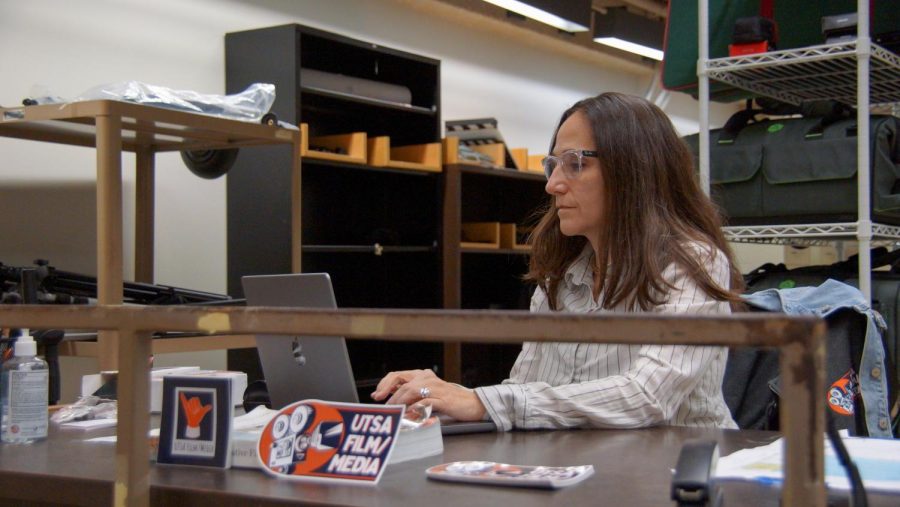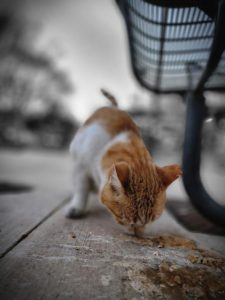Second semester of Film and Media program brings new courses and faculty
Guillermina Zabala Suarez at work in the Film Production Hub.
January 31, 2023
For John Herrera, teaching his first semester of the Basics of Screenwriting course happened by chance. Herrera, a professional screenwriter in California, was teaching a writing course online when he met several UTSA students.
“I was actually teaching online, at a website called writingpad.com, and I had a couple of students who were friends of the other professor teaching this [course], Rebeca Gomez,” Herrera said. “They actually recommended me for [the job]. I interviewed, and that was how it came up. It was because I taught somewhere else.”
Some of Herrera’s credits include “The Handmaid’s Tale,” “Nancy Drew & The Hidden Staircase” and “The Vampire Diaries,” to name a few. The Fall 2022 semester was his first at UTSA, and with it came the opportunity to be a part of a unique program — one that gives a film school education, on a local level, to a diverse range of students.
“That was one of the things that attracted me to this,” Herrera said. “Because I like the idea of teaching at a university, but I really loved the fact that this was, for a lot of people, who [were] maybe the first in their family to go to school, that’s just amazing. My dad was that in my family; it’s great to be a part of that.”
In its first semester, the program had 71 students registered under the major. Program Director Dr. Paul Ardoin described how that number grew by the end of the semester
“Well the first thing that is changing is more students,” Ardoin said. “We started as a large program this semester. I think we had 71 students on the first day of classes. And then, by the end of the semester, I got an update that we were up to 93.”
Ardoin described the steps the program must take before transitioning to the College of Liberal and Fine Arts.
“It’s gotta go to the faculty senate to be approved; it’s gotta be approved by the Texas Coordinating Board … all the way up this long line that really does take two years to happen,” Ardoin said.
Despite the program not yet falling under the umbrella of the College of Liberal and Fine Arts (COLFA), Ardoin praised COLFA for their support in budgeting for the program.
“The COLFA dean has given us a budget and then given us things beyond that budget for individual events,” Ardoin said. “The reason this is significant is that these aren’t even technically COLFA students. Currently, everyone is in University College. So to see this level of support from COLFA is really encouraging.”
Furthermore, in 2022, the program received a Strategic Investment Fund (SIF) grant to assist with the renovation of the film production hub inside the McKinney Humanities Building. The location currently houses an editing room, several workspaces, an equipment room and a green screen space outfitted with industry-grade lighting.
Several new faculty members also joined the program for its second semester. Ernest Hernandez, who works for the Office of Academic Innovation, is teaching a section of Digital Video Production. Another faculty member new to the program is Guillermina Zabala Suarez. Having previously worked as a Media Arts Director for SAY Sí for 17 years, Zabala Suarez has been ingrained in media culture.

At UTSA, Zabala Suarez is teaching three courses: Digital Media Production II, Digital Video Production and Film and Medicine, the latter of which is a new course. Zabala Suarez worked closely with Ardoin and Dr. Serife Tekin from the Medical Humanities department to design the Film and Medicine course syllabus. Several other organizations helped with the course, including San Antonio Metro Health and the Westside Community Partnerships Initiative.
Zabala Suarez described what students can expect from the course.
“The idea of the course is an intersection between medicine, health and film,” Zabala Suarez said. “Understanding how media — film, tv — and other media components are portraying health and medicine. On the other hand, it’s also a hands-on production class; where students actually get to learn all of the stages of, mainly, documentary production.”
Students will end the course by producing short documentaries exploring different health issues affecting the San Antonio community.
A goal for the program is to be able to attract students interested in film to be able to receive their education in San Antonio, rather than having to venture to Austin or out of state. For Zabala Suarez, getting to work at a program that reminds her of the high school students she worked with at SAY Sí is special.
“It was not just a personal opportunity, but an opportunity for the city to be able to participate in the development of a program that a lot of my former students wanted for a long time,” Zabala Suarez said.
Zabala Suarez wanted to be a part of a program that was encouraging collaboration, while also reinforcing that San Antonio is a city for filmmakers, and the Film and Media program is the education students can get.
“When I learned that this was happening, and I learned that there was an opportunity for me to apply … I really wanted to make sure that this program develops the way it’s been envisioned already,” Zabala Suarez said. “A lot of high school students throughout the city could come and take classes here instead of going to Austin or out-of-state because that’s what used to happen. Now, [we] can give those students the opportunity to stay in the city, and also help promote the film industry in San Antonio.”
The Film and Media program encourages exploration and collaboration, not only within the coursework these students are exploring but even into the partnerships that help shape the program’s work.
The program experienced a rise in interest, opportunity and support during its first semester, capping off the end of the semester with student films being screened at the Santikos Palladium.
The Santikos partnership is one of many examples to show for the program’s reach into the growing San Antonio film community. For Ardoin, those partnerships are vital to student success and retention. The spring film showcase is set for Tuesday, May 2, at the Santikos Palladium. Film submissions will be open to all UTSA students. Prospective students can email Ardoin for specifics.
Over spring break, students will also get to experience what a mock writer’s room would look like. The program is flying out several industry professionals, including Herrera, and his writing partner, Nina Fiore, to work with students and their scripts.
“Professor Gomez and Herrera came up with this idea of doing a mock writer’s room, and then it just exploded from there,” Ardoin said.
Students will work in small groups, each led by a professional screenwriter, to put together a pilot script. In the end, several working Hollywood agents will appear via Zoom and listen to the student’s pitches.
For more information about the Film and Media program, check out GroupMe and Instagram.










